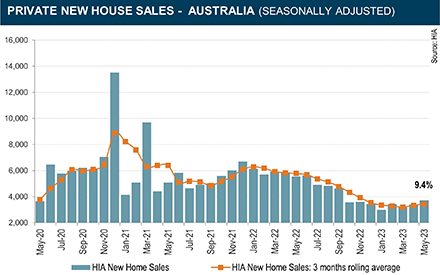
Sales of new homes across Australia increased for the second month in a row in May despite the ongoing rise in the cash rate. Source: Timberbiz
The HIA New Home Sales report – a monthly survey of the largest volume home builders in the five largest states – is a leading indicator of future detached home construction.
“Sales of new homes increased by 9.4%in the month of May 2023 compared to the previous month, leaving sales in the last three months higher by 4.4%on the previous quarter,” HIA Senior Economist Tom Devitt said.
“Despite this small rise in sales, they remain at depressed levels. Sales in the three months to May 2023 were more than 40%l ower than in the year before when interest rates started to increase, and 25% lower than prior to the pandemic. This indicates that the slowdown in home building that is underway will continue for at least the next year.”
Mr Devitt said the most significant contraction in sales was in New South Wales where customers were more sensitive to rises in the cash rate.
“Cancellations also remain elevated at a rate of 25% in the last quarter. This means, for every four new projects a builder is recording, a previous project is being cancelled,” he said.
The RBA’s rate increases would continue to hold down new sales and cause further cancellations as finance became unobtainable for an increasing number of buyers.
“The significant increase in the cost of land and construction across all jurisdictions over the past two years is compounding the impact of higher interest rates. The additional costs of compliance with the National Construction Code, that come into effect this year, will further increase the cost of new home construction and dampen demand further,” Mr Devitt said.
“This combination of factors will see home building continuing to contract for at least the next 12 months to its lowest level in more than a decade.”
Sales of new homes in the three months to May 2023 compared with the same time last year are still down in most large states, led by New South Wales (-63.6%), and followed by Queensland (-52.9%), Victoria (-46.6%) and South Australia (-29.5%). Western Australia saw the only increase over the year, up by 19.4%.





